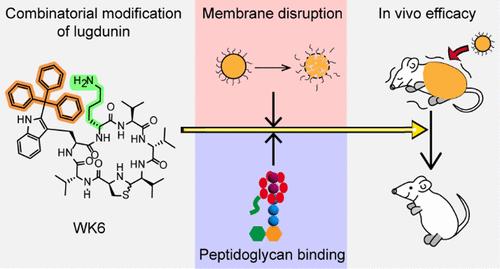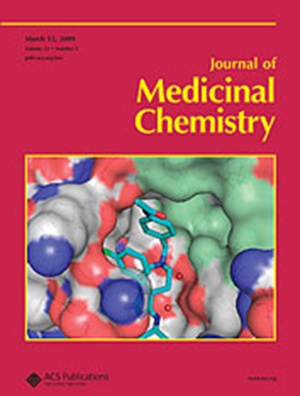Discovery of Cationic Lugdunin Derivatives with Membrane-Disrupting Activity against Resistant Bacteria via Radical Reactions and Amino Acid Mutations
IF 6.8
1区 医学
Q1 CHEMISTRY, MEDICINAL
引用次数: 0
Abstract
Lugdunin was the first reported new class of thiazolidine cyclopeptide antibiotic from human microbiomes. However, its structure could not accommodate polar amino acids or modules, limiting its potential for chemical modification and clinical application. Herein, we developed a combinatorial modification strategy based on in situ modification of tryptophan through a radical reaction and amino acid site-specific mutation, transforming lugdunin into a cationic cyclic peptide antibiotic. Among the derivatives of lugdunin, WK6 was identified as a highly potent membrane-active antibiotic with rapid bactericidal activity and low resistance development potential. Remarkably, it showed therapeutic efficacy in MRSA-infected murine models of keratitis, pneumonia, and peritonitis. Additionally, when grafted onto contact lens Surfaces, WK6 exhibited potent antifouling capabilities, highlighting its potential in implant antifouling applications. Therefore, this study developed an effective strategy to optimize lugdunin and unveiled a novel cationic lugdunin derivative WK6, which could be recognized as a promising lead compound to combat multidrug-resistant bacteria.

求助全文
约1分钟内获得全文
求助全文
来源期刊

Journal of Medicinal Chemistry
医学-医药化学
CiteScore
4.00
自引率
11.00%
发文量
804
审稿时长
1.9 months
期刊介绍:
The Journal of Medicinal Chemistry is a prestigious biweekly peer-reviewed publication that focuses on the multifaceted field of medicinal chemistry. Since its inception in 1959 as the Journal of Medicinal and Pharmaceutical Chemistry, it has evolved to become a cornerstone in the dissemination of research findings related to the design, synthesis, and development of therapeutic agents.
The Journal of Medicinal Chemistry is recognized for its significant impact in the scientific community, as evidenced by its 2022 impact factor of 7.3. This metric reflects the journal's influence and the importance of its content in shaping the future of drug discovery and development. The journal serves as a vital resource for chemists, pharmacologists, and other researchers interested in the molecular mechanisms of drug action and the optimization of therapeutic compounds.
 求助内容:
求助内容: 应助结果提醒方式:
应助结果提醒方式:


